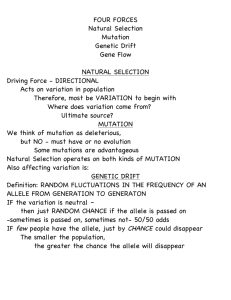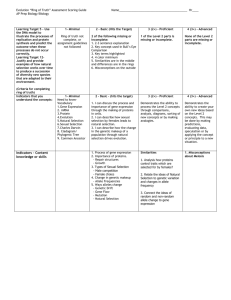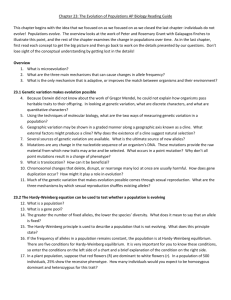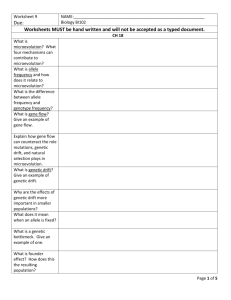Defining evolution
advertisement
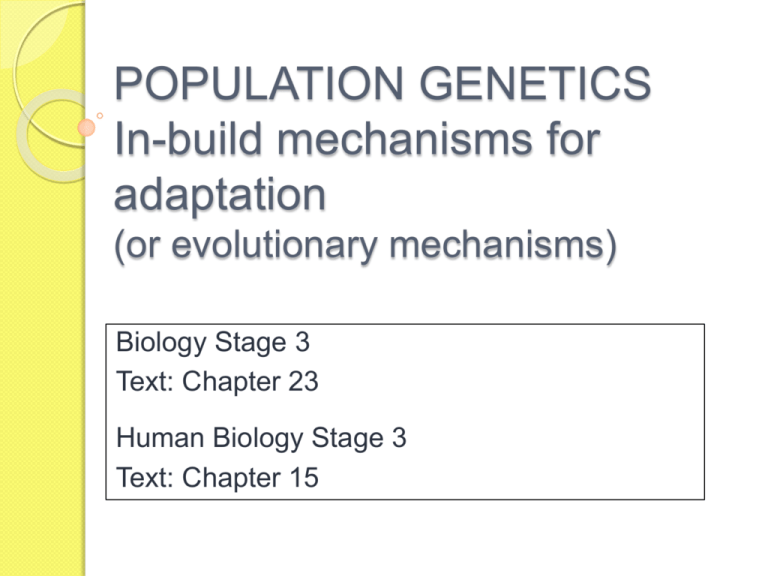
POPULATION GENETICS In-build mechanisms for adaptation (or evolutionary mechanisms) Biology Stage 3 Text: Chapter 23 Human Biology Stage 3 Text: Chapter 15 Key ideas Population genetics Observable facts Natural selection Mutations Biological fitness Genetic variation Genetic drift Speciation Bacterial resistance We will be looking at population genetics. These concepts are not related to evolution, although in your textbook they are automatically linked. The processes involved in population genetics are directly observable and can be studied scientifically. The theory of evolution Remember … The theory of evolution proposes that life arose from non-life and that this process has taken billions of years. It is closely linked to the Big Bang theory, being a continuum in the spectrum of the ‘evolving’ universe. This theory is based on an atheistic worldview. Definitions Species A group of individuals who are able to interbreed, producing fertile offspring Population A group of organisms of the same species living together in a particular place at a particular time Gene pool The sum of all alleles in a given population Allele frequencies How often a particular allele occurs in a population Natural selection Definition Natural selection occurs when environmental conditions favour one allele at the expense of other alleles The result is that the process of natural selection enhances the chances of survival in particular environments Despite this definition, natural selection is mostly not a strong enough process to favour single genes. Rather, environmental conditions act to favour multiple characteristics that enhance survival. Example The difference between the Inuit and Masai (pg. 251) Population size and allele frequency In large populations: Individuals make only a small contribution to the gene pool. Allele frequencies are relatively stable and change slowly over time These patterns depend on: ◦ Dominance ◦ Co-dominance ◦ Monogenic inheritance ◦ Polygenic inheritance In small populations: Individuals make a relatively large contribution to the gene pool. Change in allele frequency can occur rapidly. Many changes are due to chance events. Population bottlenecks A bottleneck is caused by events that create a sudden drop in population size (e.g. wars, natural disasters or migration) or prevent individuals from reproducing. This reduces mating possibilities and can cause a genetic bottleneck. Example Noah’s flood In-breeding Reduced mating opportunities often lead to an increase in in-breeding or consanguinity. In-breeding results in reduced genetic diversity in the population’s gene pool. The Pharaoh and Inca nobility practised consanguinity to preserve the 'purity' of their gene line. Consanguinity the Old Order Amish community of Lancaster County in Pennsylvania, USA is a fundamentalist religious sect who do not marry out or use modern technology. The Amish community numbers around 18 000 people and shares only eight family names. Within the community there is an above average incidence of inherited illnesses including a rare form of microcephally (small brain), albinism, dwarfism, cretinism, webbed fingers and limb girdle muscular dystrophy. Genetic drift Genetic drift is the random fluctuation of allele frequencies in a population from one generation to the next. Example The frequency of a particular trait could, for no obvious reason, drift from 2% in generation A, to 11% in generation B, to 5% in generation C Genetic drift is often a consequence of a genetic bottleneck It results from in-breeding brought about by the limited mating possibilities in a small community. The effects of genetic drift The effects of genetic drift can be amplified by differences in the number of children raised by couples or individuals dying prematurely. Genetic drift can result in: traits being lost from small populations. unusual traits, not commonly found in the parent population, and that are often nonadaptive, becoming established. Genetic drift The founder effect Founder effect is an example of a genetic bottleneck. Founder effect occurs when a small number of people migrate and settle in a new area. The founding population carry only a small fraction of the original population's genetic variation. As a result, they may differ both genetically and in appearance, compared with the parent population. The founder effect Pitcairn Island, in the Pacific, was colonised by the mutineers from HMS Bounty in 1790. Today the population of the island is around 44 people. Gene flow Migration is describes as gene flow from one population to another This brings in new alleles into the population The allele frequencies for that gene will be altered over time Example Chinese only had Rh+ allele until Europeans came and brought in Rh- allele Barriers to gene flow Populations are often kept apart by physical or social barriers These may result in populations becoming less alike over time. Isolation due to barriers results in separate gene pools Barriers include: Geographical barriers Sociocultural barriers Heterozygous advantage Genetic diseases result in changes to the allele frequency in a gene pool. Some alleles that cause fatal diseases can persist in the population because, in some cases, it can be advantages to be the carrier of a fatal allele This is called heterozygous advantage. Examples Sickle cell anaemia Tay-Sachs disease Sickle-cell anaemia Occurrence African continent Advantage Individuals have some immunity to malaria Tay-Sachs disease Tay-Sachs is lipid metabolism disorder caused by a missing enzyme. This results in the accumulation of a fatty substance in the nervous system Death usually occurs at age 4 or 5 Occurrence Individuals of Jewish descent from Eastern Europe (Ashkenazi Jews) Advantage Individuals have some immunity to tuberculosis (TB) Speciation The development of different species over time Steps to speciation: Variation A single population exists with a common gene pool Isolation A barrier forms and divides the population into 2 Selection Different selection pressures exist for these 2 populations Speciation Over time, the allele frequencies in each of the populations change When the two populations no longer interbreed, a new species is said to have ‘evolved’ Mutations Mutations A change in the DNA sequence. Can result from DNA copying mistakes, exposure to radiation, exposure to chemicals or infection by viruses. Mostly have deleterious effects Gene mutations Changes in the DNA of a single gene ◦ Example: Phenylketonuria Chromosome mutations All or part of the chromosome is affected ◦ Example: Down’s syndrome Mutations Somatic mutations A mutation in the body cells Germinal mutations A mutations in the gametes Three types of mutations National Human Genome Research Institute - NIH Evolutionary mechanisms Alfred Wallace Charles Darwin Charles Darwin and Alfred Wallace proposed that natural selection and mutations are the two main forces that drive evolutionary mechanisms. The theory requires that new genetic material is created over time by random natural forces. In-built mechanisms for adaptation Creation scientists propose that God created living organisms with an immensely complex yet flexible genetic code that enables them to adapt and change to survive in different environments. This theory proposes that existing DNA is modified according to natural selection, genetic drift and population bottlenecks, rather than new genetic material being created.



